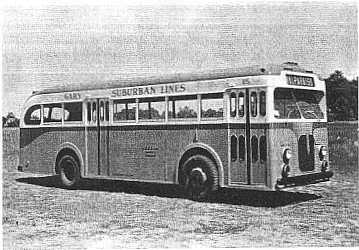
|
Gary-Hobart-Valparaiso Transit 115, a model 310 Cityliner turned out in July 1945. The standard engine in these buses was the Hercules JXD, a 95-hp 6-cyiinder powerplant. Buses similar to this were built between 1944 and 1947, when the design was changed and standee windows were added. |
Regular bus production ended in the fall of 1942, though a few 610's were not delivered until the spring of 1943. A special type of model 100 using wood for the conversion and containing 15 back-to-back seats was designed and built in large numbers. Many of them were assigned by the Office of Defense Transportation to common carriers while others, often built from Pontiac or Packard cars, were delivered to the U.S. Army. Also in 1943, FitzJohn was commissioned to build 62 tractor-trailer buses, for which GMC tractors were used to pull enclosed auto-hauling trailers.
The gradual availability of engines and metal after the summer of 1943 enabled the WPB to authorize FitzJohn's return to the bus business; the company was perhaps the first to resume actual bus production, in December 1943. The Duraliner and the Falcon were continued without change, but the transit model was redesigned with its front door ahead of the axle and designated model 310. After advertising was resumed in 1945, this bus became known as the Cityliner.
Model 510 The biggest seller among FitzJohn's many models of complete busess the model 510 Duraliner; 499 units were shipped between 1946 and 1952 (see cover photo). It differed from the earlier model 500 in having a 131-hp Hercules JXLD engine in
|
Grey Bus Line (Moncton, H.B.) 77 was the first rear-engine FTG Cityliner to be built at the Canadian plant; it was delivered in January 1951. [Paul Leger] |
16
Previous Page Next Page Main Page